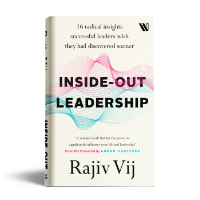
Photo by h.koppdelaney
There comes a time in our life when a strong feeling of incompleteness gnaws at us. We feel stagnated or unfulfilled at work, sorely miss the romance in our marriage, are frustrated at the rejection from our children, and feel helpless at our receding hairline or expanding waistline. Termed as mid-life crisis and generally occurring sometime in our 40s or 50s, it’s a time of emotional turmoil and unanswered existential questions.
Losing a parent brings us face to face with our own mortality and the thought that we may have fewer years left than we have already lived makes us anxious. Injuries take longer to heal and every heartburn seems like an alarm for something more serious. The realization that there are some life goals we will never hit, contrary to the exuberance of our youthful days, adds to the fear of time running out. We wonder if this is all life has to offer.
The popular response: we add more color to our wardrobe, buy an expensive car or designer merchandise, and start preparing a ‘bucket list’. We seek out new ways to fill our emotional void – some change jobs, others fall out of relationships, we look to start a new hobby, and regroup with our college mates.
The opportunity
Although it’s a passing phase and research suggests that most of us adapt to the new reality and are happier in our 60s, particularly as empty nesters largely relieved of our parental responsibilities, this time of psychological turmoil can be a profound opportunity. If harnessed well, it can be a time of awakening from our blind chase of narrowly defined goals.
Most of us spend the first half of our life pursuing what appear to be the most sought after options – the courses we take, the careers we pursue, or the places to work or live we gravitate towards. Mid-life crisis has the potency to force us to stop, reflect and focus on shaping the second half of our life on our own terms – a better expression of who we are and our individuality.
What if your best is yet to come? What if, in coming years, you could feel more complete than ever before? What if a paradigm shift was possible that allowed you to create a powerful new life for yourself? What if you could discover greater success and fulfillment in your work, deeper love in your relationships, and inherent happiness and meaning in your life?
Four steps for harnessing the opportunity
1. Reconnecting with our inner self
‘You need chaos in your soul to give birth to a dancing star.’ ~ Friedrich Nietzsche
Rather than getting weighed down by the disturbing emotions of this time, and wish them away, we need to acknowledge their existence, make peace with them and tune into what they are trying to tell us. This requires creating regular time for reflection where we can detach ourselves from our subconscious stream of thoughts and feelings and observe them objectively.
Examining our thoughts and feelings from a place of inner stillness not only dilutes their negative hold on us, but also paves the way for us to learn more about ourselves. We can then perceive the genesis of our fears, self-doubts, anxiety, envy and frustration. Any form of meditation practice can be greatly helpful in this regard. Reading relevant books and articles is also supportive of this process.
Quietening the mind allows us to reframe the situation in newer ways. It’s the difference between looking at the same scenery from the fourth floor of the building and the twenty-fourth floor. The scenery remains the same, but we have a new perspective. Such soul-searching helps us identify what we need to learn in our personal situation to grow from it – is it learning unconditional love, self-acceptance, letting go, responsibility, courage, or compassion?
2. Questioning our limiting beliefs
‘An unexamined life is not worth living.’ ~ Socrates
How we experience our reality is a direct reflection of our belief systems. Through structured reflective pauses, particularly with meditation, we gain insights about our deep-seated beliefs that are at the source of our troubling thoughts and feelings – beliefs about our own identity, careers, love and relationships, money, giving, the right way to conduct life and so forth.
For example, what beliefs do you have about success – how do you weigh material progress versus spiritual growth; financial success versus social contribution; career growth versus family and emotional well-being. Your responses dictate the kind of profession you choose and the kind of life you lead. As we reform our beliefs and let go of the ones that no longer serve us well, we give ourselves a great shot at creating a paradigm shift in our life (Read: To create a new reality, start with your beliefs).
Similarly, examining our beliefs about our identity and building a deeper understanding of our spiritual self helps us appreciate the truth of our existence and meaning of life and death; grasping the nature of our eternal being subsides the pressure of accomplishing all our goals in this lifetime and provides us with inner strength and peace.
3. Defining a clear purpose of life
‘What lies before us and what lies behind us are small matters compared to what lies within us. And when we bring what is within us into the world, miracles happen.’ ~ Henry David Thoreau
Persevering with these reflections throws light at the futility of some of our mindless pursuits – actions that may well have been relevant for the first half of our life, but ones we could do well to let go of for a meaningful second half. However, to reinvent ourselves, we need to develop a clear picture of what we want the rest of our life to be about.
I believe each one of us is uniquely gifted and has a specific purpose to fulfill in a lifetime – but we need to temporarily get off the treadmill of activity to discover this purpose. The inner turmoil of the mid-life crisis creates the most fertile ground for this discovery – we are young enough to be bold and wise enough to assimilate the experiences, successes and setbacks of our first half.
I recommend writing a statement, in no longer than one sentence, describing the purpose of the rest of your life – what’s that singular pursuit that would be most meaningful for you; the one you would be most happy and proud of when you are 85 years old, having dedicated the previous three-four decades towards. Defining a clear life’s purpose is a liberating exercise – the purpose connects us to our deepest inspiration, becomes our core anchor, and sets a powerful direction for the rest of our life (You may also like to read: Discovering your calling).
4. Committing to becoming who we are meant to be
‘A ship is safe in harbor, but that’s not what ships are for.’ ~ William Shedd
When we slow down and listen to the small voice within, it guides us to what we truly want our life to be about – not the one goaded merely by popular trends, but the one that’s a true expression of who we uniquely are. Many a time, we connect with such inspiration on that long weekend, but come Monday morning and we get sucked into the demands of our daily life and lose the spark.
Addressing our limiting beliefs and committing to manifest our chosen life purpose paves the way for creating a happy and fulfilling second-half of our life. Pursuing this purpose does not always mean altering the entire contours of our life, including career or lifestyle; however, it does begin to shape our relationship with whatever we are engaged in.
We start to discover new growth and meaning in our work by either committing to pursue our calling or having a new-found purposeful relationship with our existing work; we become open to overcoming whatever is holding us back in our relationships and discover deeper love and intimacy in our marriage; reform our outlook towards the role of parenting and start enjoying a wonderful friendship with our children; and living our life’s purpose adds happiness and meaning to our journey.











 Meditation III: Joy of Mindfulness
Meditation III: Joy of Mindfulness Teenage Children: An Undeniable Learning Opportunity For Parents
Teenage Children: An Undeniable Learning Opportunity For Parents Too Much Of A Good Thing Is Not Necessarily Good
Too Much Of A Good Thing Is Not Necessarily Good Two Questions Worth Asking Yourself This New Year
Two Questions Worth Asking Yourself This New Year Expressing Difficult Emotions
Expressing Difficult Emotions
Dear Rajiv,
Very apt article for people like me in mid 40’s. Self realisation on how my career progress has been constrained by my own immediate superiors and I was so naive of not realising about; realising it now is creating more frustration about myself;
Well, the business maturity gained over the years has enabled me into a full fledged professional to mantle leadership position in my line of industry – which is wealth management and distribution of third party products – expecially for leading corporate business conglomerates who want to start this business from the scratch
Warm regards
Govind
From menopause to meno-pass is just an Attitude Belief Can-do .. away. ABC, Dear Guru. Nice views, Rajiv.
Thanks Rajiv for this timely post. I struggled a bit with the importance of writing one’s life’s purpose in one statement, considering that this is different from Stephen Covey’s approach of having several roles in our life (profession, parent, partner, colleague, etc) and having 1 statement for each.
However, when I reflected on this, and re-read the para of yours a few times, it dawned on me as to how having one statement would become an anchor for all areas of our life. Thanks so much for this.
One question – Covey also talks about revisiting one’s mission statement periodically. What’s your take on revisiting this “life purpose in one sentence”?
Glad to hear it was helpful.
As regards revisiting the purpose statement is concerned, my view is that if you’ve got the right one, it should be timeless and relevant for the rest of your life, and barring some significant new insight that life may bring to you, you should not have to review the statement. Surely, its greatly helpful to refer to it on a routine basis.
Regards, Rajiv
Thanks Rajiv for sharing your views on mid-life crisis and challenges one faces in this phase of life. With increasing urbanization and Westernization, we have been leading mechanical, robotic lives and most of us have not even pondered over our ‘purpose in life’. Maintaining a work-life balance in our fast-paced corporate jobs is a big challenge, and there’s no time for self-introspection. We need to step back and take an objective view of what we are doing and where our life is headed during our mid-life phase. But, though I agree with your four points above, mid-life is rather late to introspect and make course-correction for a more ‘fulfilling’ life, with responsibilities (of providing for a family, caring for aging parents, etc.) which prevent us from risking a ‘safe’ livelihood. Hence, most of us compromise with our own dreams and aspirations in the interest of those whom we provide and care for. Nevertheless, you article could be a reference for those who have the luxury to experiment with their mid-life, and hopefully lead a more contented and fulfilling life.
Hi Ramesh:
Thank you for sharing your thoughts. I agree, sometimes driven by our family and other responsibilities, we are challenged to make a substantial shift in pursuing our dreams. However, the four-points I narrated, can help us create a new relationship with whatever we are engaged in. We can start to connect with the same work with a different purpose – maybe focus more helping others at work, or commit to overcoming our limiting beliefs and enjoy greater mental freedom…
Very nicely written. Enjoyed reading it. Was reminded of John Wood’s (Room To Read’s Founder) interview with Oprah. When he decided to quit his high paying job at Microsoft and start libraries in developing countries, people asked him’ “Are you having a mid-life crisis?” His response was, “Wouldn’t it be a bigger crisis if I do not follow my heart and my passion?”
https://www.youtube.com/watch?v=MrE55sPw89k
Good one Ramya, thanks for sharing!